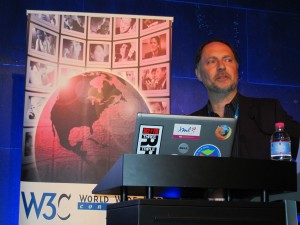 Ensuring the Internet is available to all – whether computers or people – was a central theme of this international conference.
Ensuring the Internet is available to all – whether computers or people – was a central theme of this international conference.
About 800 people gathered in Sydney on October 13-14 for the Web Directions South conference, the premier conference for Web professionals in Australia. For the third year running, the W3C Office Australia hosted the W3C South Track, a two-day thematic track that runs in parallel to the design, business and development tracks and is fully integrated in the two day program of the Web Directions South conference.
This year’s feature topic was accessibility. The W3C’s Web Content Accessibility Guidelines version 2.0 (WCAG 2.0) have been adopted by the Australian Government and all government websites, including CSIRO’s, must comply by 2012.
The Guidelines are designed to make web content more accessible to people with disabilities beyond vision impairment, as well as older individuals with changing abilities, but following the guidelines tends to make web content more usable for everyone.
Andrew Arch (part of the team who developed the Web Accessibility National Transition Strategy to help Australian Governments adopt WCAG 2.0) described ways to simplify the task of improving the accessibility of content and Gian Wild (who spent six years writing the WCAG 2.0 Guidelines) demonstrated useful techniques for achieving compliance with WCAG 2.0.
The W3C South Track also covered development of open standards and guidelines for web languages and protocols. Peter Mika, from Yahoo Research in Barcelona, told of how search engines will soon be able to answer complex questions. Other points of interest included augmented reality, the mobile web and how practical publishing tools are shaping the web experience at the Australian War Memorial.
See slides from the talks http://south11.webdirections.org/.
